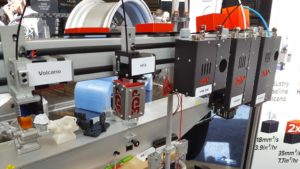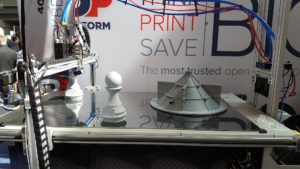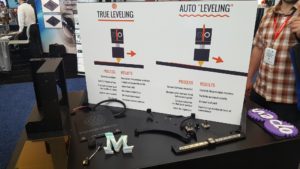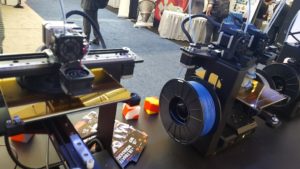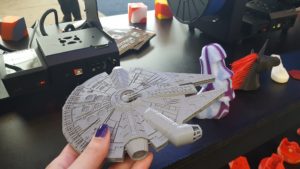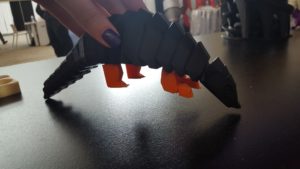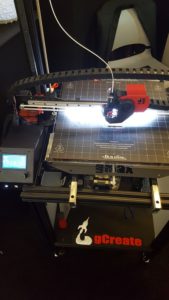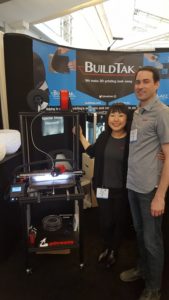RAPID Wrap-Up: 3Diligent, 3D Platform, MakerGear, gCreate Offer Sturdier, Bigger, Faster 3D Printing
3D printing has a lot of demands placed on it: customers want more options, faster, bigger, sturdier, more reliable. At RAPID, I had the opportunity to speak with some of the companies striving to meet these demands, including 3Diligent, 3D Platform, MakerGear, and gCreate. Many events are over as soon as closing time hits, but for some of the biggest shows in the 3D printing calendar year, the conversations continue even weeks thereafter. It’s hard to believe it’s already been three weeks since the last day of RAPID + TCT show, but somewhat less tough to believe that there’s still more to say about what happened this year in Pittsburgh. The show for 2017 was bigger (and better?) than ever before, with thousands of attendees and hundreds of exhibitors.
3Diligent
 3Diligent, as ever, made my job easy. As I approached the booth, CEO Cullen Hilkene opened his arms wide with a smile, announcing:
3Diligent, as ever, made my job easy. As I approached the booth, CEO Cullen Hilkene opened his arms wide with a smile, announcing:
“We have HP!”
I last chatted with Hilkene in December at Inside 3D Printing San Diego, where the company had been focusing on an expansion of capabilities in metal 3D printing technologies. They’re still expanding capabilities across the board, and access to HP’s Multi Jet Fusion 3D printing technology is definitely something to be excited about.
“We have HP in the field, so anyone who needs parts has access now,” Hilkene noted.
While materials available on the HP machine remain limited to black nylon at present, the company is clearly making headway in broadening that portfolio; the current limitation doesn’t bother Hilkene, who noted that Henry Ford started the same way. (‘You can have it in any color you want, as long as it’s black,’ to paraphrase.) And 3Diligent isn’t at a loss for other materials; as we’d last spoken about metals, Hilkene also said that they have pre-orders in place now for the Metal X system from Markforged, and expect to see those come to fruition in the next few months as the anticipated machine from the high-strength manufacturer hits the market. 3Diligent is doing its due diligence in keeping an eye on the market, and Hilkene hinted toward some potential partnerships in the works to make available additional technologies.
3D Platform
 3D Platform has been keeping busy lately, and we’ve been doing our best to keep up with them. We’d been anticipating their newest systems ahead of RAPID, and weren’t disappointed once we got to Pittsburgh to see what the prolific company has been up to. I chatted with Jonathan Schroeder, President of 3D Platform, as we caught up on what’s new since we last saw one another at formnext in November.
3D Platform has been keeping busy lately, and we’ve been doing our best to keep up with them. We’d been anticipating their newest systems ahead of RAPID, and weren’t disappointed once we got to Pittsburgh to see what the prolific company has been up to. I chatted with Jonathan Schroeder, President of 3D Platform, as we caught up on what’s new since we last saw one another at formnext in November.
“January 2016 was the launch of the Workbench, and since then customers have been pulling us in two directions; they wanted a lower price point from $27K and wanted faster speeds,” he told me.
 The Workbench has proven to be extremely interesting to customers, and the new 100 series responds to the call for a lower price, starting at $15K and allowing for 1 x 1 x 1/2 m builds. From there, he said, the newer machines — the 200, 300, and 400 — offer different price/performance points based on what a given customer might need. 3D Platform has also added enclosures for all their machines, and customers can choose additional features if they’re so inclined, and not pay for what they don’t want. Answering the call for faster speeds, 3D Platform’s new extruders — which are backward compatible — can up to double output with each extruder step up, going so much as 16 times faster than what was possible last year.
The Workbench has proven to be extremely interesting to customers, and the new 100 series responds to the call for a lower price, starting at $15K and allowing for 1 x 1 x 1/2 m builds. From there, he said, the newer machines — the 200, 300, and 400 — offer different price/performance points based on what a given customer might need. 3D Platform has also added enclosures for all their machines, and customers can choose additional features if they’re so inclined, and not pay for what they don’t want. Answering the call for faster speeds, 3D Platform’s new extruders — which are backward compatible — can up to double output with each extruder step up, going so much as 16 times faster than what was possible last year.
Additionally serving customers’ needs, 3D Platform offers a Rebuild program, through which, Schroeder explained, any customer can send their machine back and have the old electronics stripped, updates added in — and get back a machine 15 times faster than what they’d purchased four years ago.
“This has been very welcomed,” he told me. “Customers say they want these things from manufacturers, and it’s nice to see a company live up to that. We announced this at AMUG, and formally last week. We kicked it off this week, and four or five customers here said they want to do it.”
 Schroeder also pointed to the company’s Excel Series, which incorporates subtractive technology in addition to additive. This, he said, is currently the world’s largest commercially available for sale 3D printer, offering the flexibility to choose how many gantries in a scalable system. If a customer were so inclined, they could order an Excel system large enough to 3D print an entire school bus. I’d like to see that.
Schroeder also pointed to the company’s Excel Series, which incorporates subtractive technology in addition to additive. This, he said, is currently the world’s largest commercially available for sale 3D printer, offering the flexibility to choose how many gantries in a scalable system. If a customer were so inclined, they could order an Excel system large enough to 3D print an entire school bus. I’d like to see that.
In addition to its own hardware, 3D Platform is also focusing on the industry at large, as Schroeder noted that they have been reaching out to material and hardware companies to start a dialogue among suppliers to weigh in on standards for materials to avoid issues. As the company was showing off its 6mm (!) filament at RAPID, such diameters struck many visitors as, well, out of the ordinary; when most filament-based extruders process standard filament at considerably smaller diameters (commonly 1.75mm and 3mm), large-format 3D printers often turn to thicker strands — which have not been standardized. Among the companies involved in these discussions so far are Ultimaker, Titan Robotics, E3D, Polymaker, MakeShaper, and Essentium. As the 3D printing industry continues to mature, standards will become a more glaring need, and dialogues such as this will prove interesting to follow.
MakerGear
 MakerGear has been making the rounds lately, as we’ve been hearing more frequently from this Ohio-based manufacturer of desktop 3D printers with a reputation for being workhorses. Having introduced the new M3 line just a week before RAPID, MakerGear had a lot to show off on the show floor. As I chatted with Founder and CEO Rick Pollack, a quick interaction with one visitor to the busy booth summed up what MakerGear stands for with its workhorse offerings.
MakerGear has been making the rounds lately, as we’ve been hearing more frequently from this Ohio-based manufacturer of desktop 3D printers with a reputation for being workhorses. Having introduced the new M3 line just a week before RAPID, MakerGear had a lot to show off on the show floor. As I chatted with Founder and CEO Rick Pollack, a quick interaction with one visitor to the busy booth summed up what MakerGear stands for with its workhorse offerings.
Visitor: “What sets you apart from the rest?”
Pollack: “Quality.”
 We’ve been learning a lot about MakerGear lately, and Pollack’s ability to sum up the company’s differentiating point so succinctly speaks to the philosophy underlying the company he has built, and the machines it builds. MakerGear 3D printers haven’t developed their reputation for quality printing at the desktop by a fluke, but by careful attention to every step of their creation. The M2, introduced in 2012, underwent more than 50 incremental improvements through its five generations of development, and it doesn’t seem a stretch to imagine that the M3 is already being subjected to scrutiny about where it can be tweaked for improvement.
We’ve been learning a lot about MakerGear lately, and Pollack’s ability to sum up the company’s differentiating point so succinctly speaks to the philosophy underlying the company he has built, and the machines it builds. MakerGear 3D printers haven’t developed their reputation for quality printing at the desktop by a fluke, but by careful attention to every step of their creation. The M2, introduced in 2012, underwent more than 50 incremental improvements through its five generations of development, and it doesn’t seem a stretch to imagine that the M3 is already being subjected to scrutiny about where it can be tweaked for improvement.
I’ve seen Pollack, and an M2, since RAPID already, as both he and the 3D printer were present at Additive Engineering Solutions’ open house in Akron, Ohio where the M2 complements the other showpiece 3D printer in that company’s facility: a BAAM. Just as the M2 isn’t out of place near a BAAM system, MakerGear does seem to fit in wherever it shows up.
gCreate
 gCreate, based in Brooklyn, New York, came to RAPID for the first time this year, founders and partners Anna Lee and Gordon LaPlante told me as I visited them where they were sharing booth space with BuildTak. They’re still a small team, starting off as a duo and launching on Kickstarter in 2013, and now the “still small” company has about six employees. gCreate has been growing, including moving to a larger Brooklyn HQ last summer, and their focus is on doing so with a strong vision, they explained.
gCreate, based in Brooklyn, New York, came to RAPID for the first time this year, founders and partners Anna Lee and Gordon LaPlante told me as I visited them where they were sharing booth space with BuildTak. They’re still a small team, starting off as a duo and launching on Kickstarter in 2013, and now the “still small” company has about six employees. gCreate has been growing, including moving to a larger Brooklyn HQ last summer, and their focus is on doing so with a strong vision, they explained.
“We’re constantly reinvesting profits, and building the business organically,” Lee told me.
Since the 2013 Kickstarter, gCreate has introduced the third 3D printer in the series, having followed up the 1.0 Kickstarter kit with a 1.5 partly assembled kit and the 1.5+ fully assembled printer. Last spring, the company released updates for its more recent releases, as well, in line with their thoughtful strategies.
“We’re constantly testing, constantly iterating,” Lee said. “So many things change along the way! We’re really excited, and hoping to launch this summer. Price per cubic inch will be lower than other 3D printers that launched on Kickstarter. The design, manufacture, and shipping is all in-house from Brooklyn, and all parts are from either the US or Europe, with powder coated steel made in Detroit.”
We’ll be following the gCreate story as it progresses — and will be hearing more from Lee soon as well, as the enterprising businesswoman will be talking with us more about building the company up and bootstrapping a success story in hectic NYC as part of our Spotlight on Women series.
Shows like RAPID are critical for getting the community around 3D printing together, as face time enhances understanding and the potential for forward momentum. Several large collaborations were announced during the event, and more contacts and leads generated during the week. The opportunity to talk with these important teams face to face is an important part of understanding the dynamics of the industry, and underlies much of our philosophy here at 3DPrint.com, where we strive to bring an in-depth view of informed news in 3D printing — direct from the source.
[All photos: Sarah Goehrke]
Subscribe to Our Email Newsletter
Stay up-to-date on all the latest news from the 3D printing industry and receive information and offers from third party vendors.
Print Services
Upload your 3D Models and get them printed quickly and efficiently.
You May Also Like
Johns Hopkins University Researchers Develop HyFAM Technology
Two scientists from Johns Hopkins University, Nathan C. Brown and Jochen Mueller, have developed a hybrid manufacturing technology they call HyFam, or Hybrid Formative Additive Manufacturing. Their work on this technology...
3D Printing G-Code Gets an Upgrade: T-Code
Good old G-Code still manages many 3D printers, great and small. Just like the STL, it’s a standard that enables collaboration while also holding the additive manufacturing (AM) industry back....
AM Rewind: The Biggest News and Trends of 2024
After a sluggish 2023, driven by persistent inflation and geopolitical tensions, 2024 has seen some recovery. Economic growth climbed from about 2.8 percent in 2023 to a modest 3.2 percent...
Metal Wire 3D Printer OEM ValCUN Announces Plans for 2025 Expansion
ValCUN, a Belgian original equipment manufacturer (OEM) of wire-based metal additive manufacturing (AM) hardware, has announced that the company has entered the next phase of its growth trajectory, making key...



